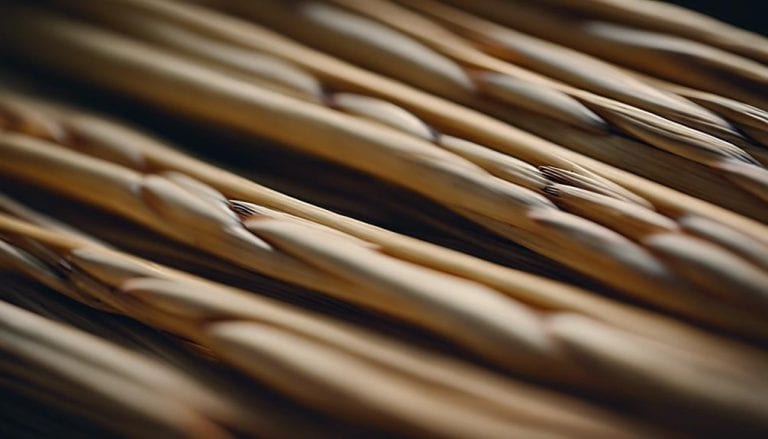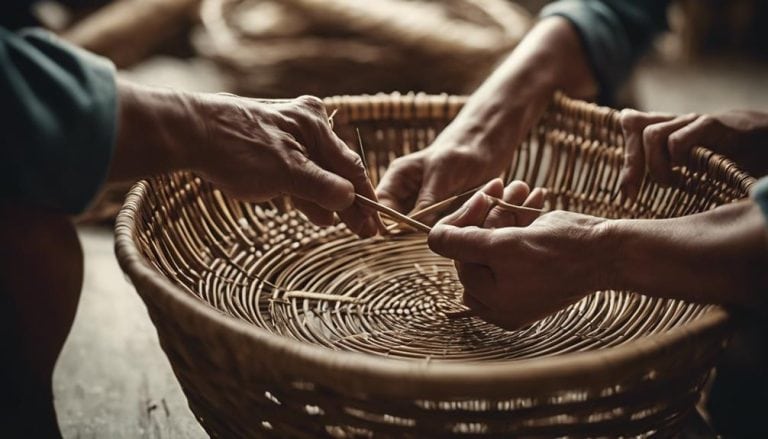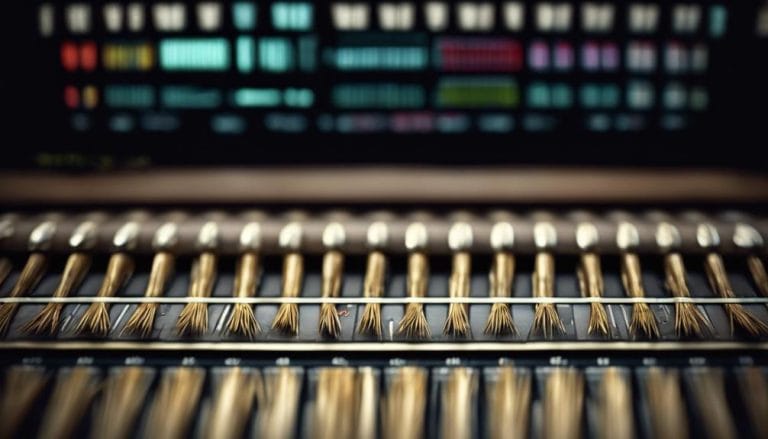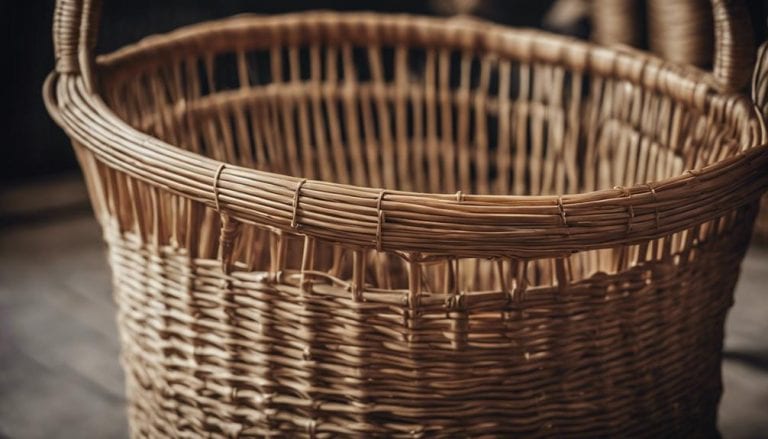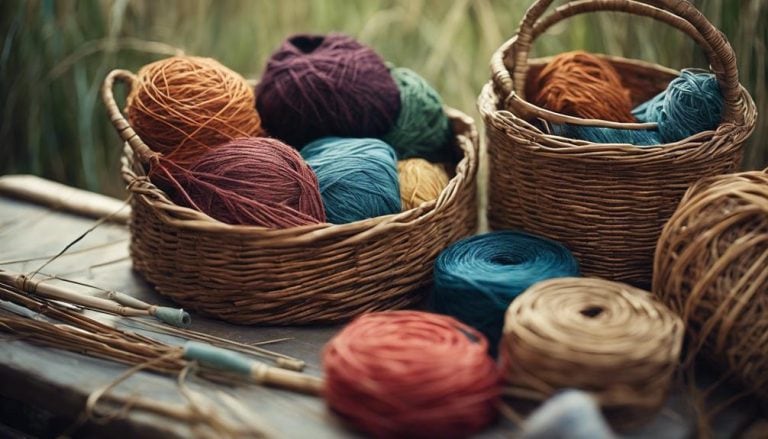Traditional Basket Weaving Materials Comparison
As a basket weaving enthusiast, I find it fascinating that willow and bamboo account for over 70% of traditional basket weaving materials used globally. However, when comparing these materials for their durability and flexibility, there are some intriguing aspects to consider.
The intricate balance between strength and pliability in basket weaving can elevate the final product’s quality. Let’s explore how these materials differ in their weaving properties and how this knowledge can unexpectedly enhance our craft.
Traditional basket weaving materials vary, with natural fibers like reeds, grasses, and vines commonly used across cultures. These plant-based resources offer unique textures and strengths, contributing to diverse artistic expressions worldwide.
Key Takeaways
- Willow and reed offer durability and flexibility for intricate designs.
- Grasses like sweetgrass and cattail provide natural strength and smooth weaving surfaces.
- Sustainability is promoted through the use of renewable materials and eco-friendly dyes.
- Natural dyes, cultural influences, and weaving techniques enhance aesthetics.
Willow Vs. Reed: Durability and Flexibility
When comparing willow and reed for basket weaving, one immediately notices each material’s distinct characteristics in terms of durability and flexibility. With its natural strength and pliability, Willow is a fantastic choice for creating intricate designs and handles in baskets. Its flexibility allows weaving techniques that result in beautifully detailed patterns, showcasing the weaver’s skill and the material’s versatility.
On the other hand, flat reed, a type of reed, stands out for its exceptional durability and ease of weaving. This makes it a popular option for crafting sturdy and functional baskets that can withstand everyday use. In terms of durability comparison, willow and reed both offer varying degrees of strength, enabling weavers to select the most suitable material based on the desired outcome of their baskets.
Willow excels in intricate weaving techniques, while flat reed creates robust and long-lasting baskets. The choice between willow and reed ultimately depends on the weaving style, design complexity, and intended use of the final basket.
Grasses in Basket Weaving: Strength and Texture
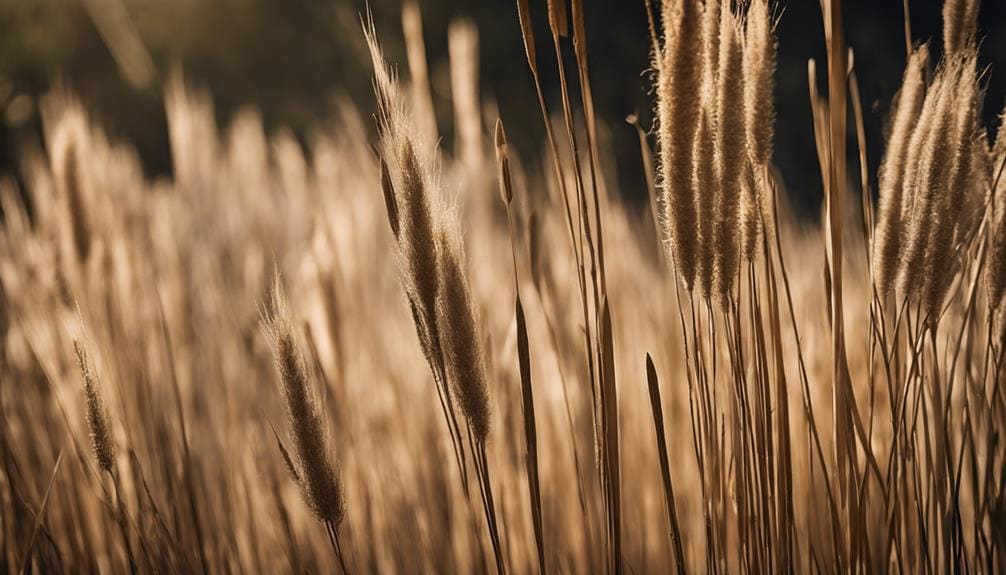
Grasses are crucial in basket weaving, contributing strength and texture for creating durable and visually appealing baskets.
- Natural fibers: Grasses, such as sweetgrass, cattail, and ryegrass, are prized for their natural strength and flexibility, making them ideal for weaving intricate patterns and sturdy structures.
- Weaving techniques: Grasses provide a smooth surface that is easy to weave, allowing for tight and secure basketry constructions that can withstand everyday use.
- Basketry traditions: Across cultures, grasses hold significant cultural importance in traditional basket weaving practices, symbolizing community, creativity, and connection to the natural world.
- Cultural significance: Using grass in basket weaving showcases the weaver’s artistry and skill and preserves ancient traditions and techniques passed down through generations.
Incorporating grass fibers into basket weaving ensures the baskets’ longevity and durability and adds a unique texture and organic charm that enhances the aesthetic appeal of the final product.
Comparing Ease of Use: Willow, Reed, and Grasses
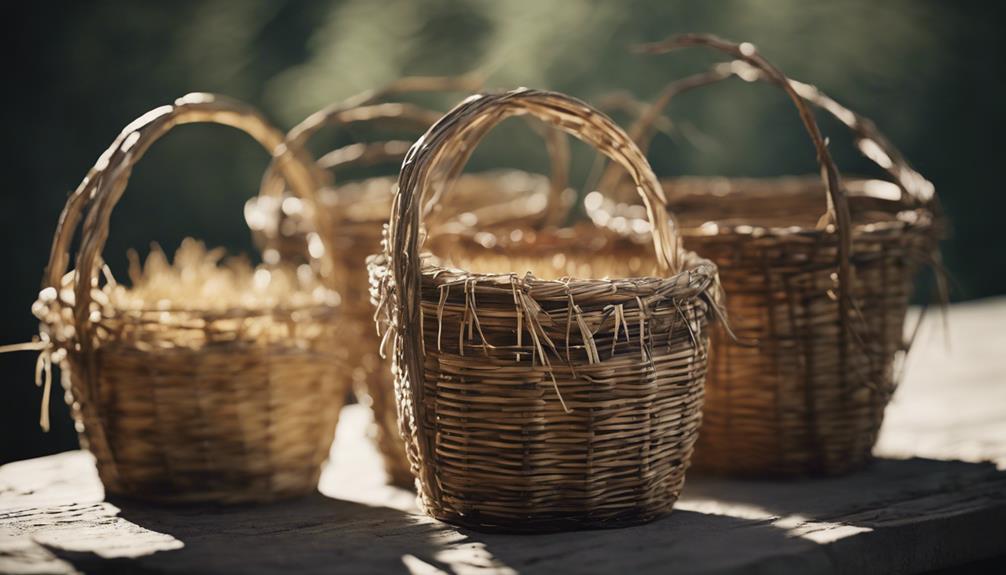
Comparing the ease of use among willow, reed, and grasses reveals distinct qualities that cater to varying skill levels and project requirements in basket weaving. Willow stands out for its flexibility, making it a go-to choice for beginners due to its forgiving nature in weaving techniques.
On the other hand, Reed offers versatility with its smooth surface and consistent thickness, which aids in easier manipulation for both beginners and advanced weavers. Grasses, being natural materials, require a bit more finesse as their flexibility and texture can vary, demanding specific weaving techniques depending on the type of grass utilized.
To further illustrate the differences in ease of use, the table below compares willow, reed, and grasses based on weaving techniques, suitability for beginners vs. advanced weavers, and maintenance tips:
| Material | Weaving Techniques | Suitable for Beginners | Suitable for Advanced | Maintenance Tips |
|---|---|---|---|---|
| Willow | Easy, forgiving | Yes | Yes | Regular cleaning |
| Reed | Versatile | Yes | Yes | Avoid dampness |
| Grasses | Varied | Depends | Yes | Gentle handling |
Sustainability Factor: Materials for Eco-friendly Weaving
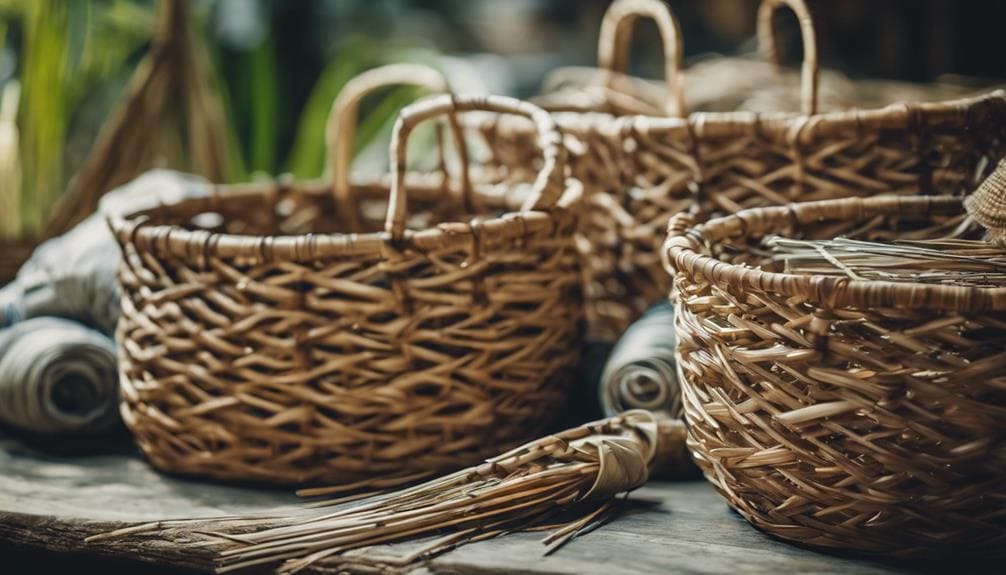
Natural materials commonly used in traditional basket weaving, such as grasses, reeds, and vines, foster eco-friendly practices and support sustainable weaving techniques. These materials are sourced from renewable sources, making them environmentally friendly and reducing the carbon footprint associated with basket weaving.
Here are four key points highlighting the sustainability factor of materials for eco-friendly weaving:
- Renewable Sourcing: Grasses, reeds, and vines used in basket weaving are natural resources that can be replenished over time, ensuring a continuous and sustainable supply for weavers.
- Minimal Carbon Footprint: Natural fibers have a lower environmental impact than synthetic materials, making them a preferred choice for eco-conscious production methods.
- Promoting Sustainability: Choosing natural materials for basket weaving encourages responsible harvesting practices and supports the long-term health of ecosystems.
- Environmentally Friendly Dyes: Natural dyes used in basket weaving further enhance the eco-friendly aspect of these materials, ensuring that the entire production process is environmentally conscious and sustainable.
What Are the Benefits of Using Durable Materials for Traditional Basket Weaving?
Using durable basket weaving materials for traditional basket weaving offers long-lasting and resilient products. These materials ensure the baskets can withstand wear and tear, making them practical for everyday use. Additionally, using durable materials ensures that the baskets remain functional and aesthetically pleasing for an extended period of time.
Aesthetics and Color Variations: Enhancing Basket Designs
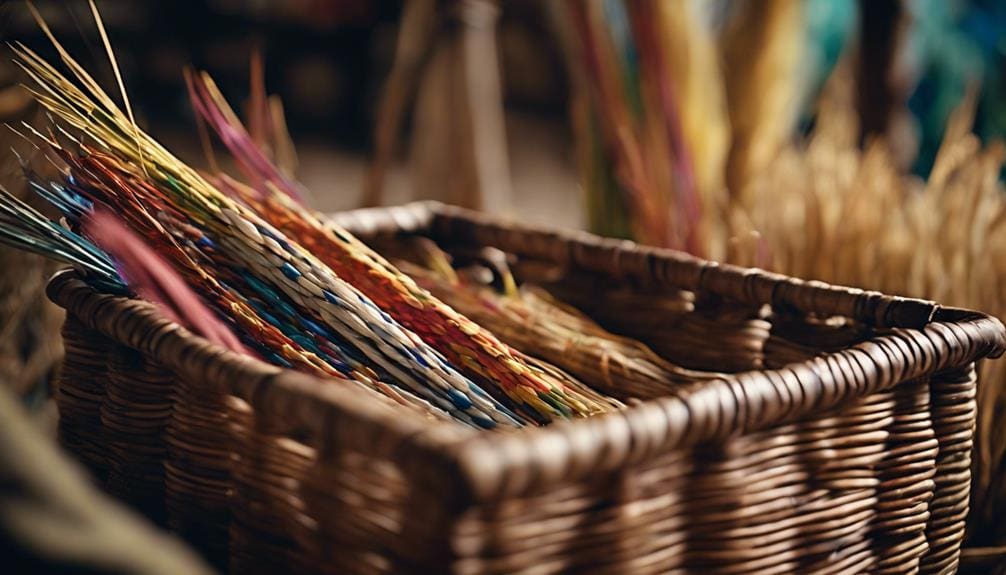
Enhancing the visual appeal of woven baskets goes beyond just the materials used; it extends to the artful incorporation of colors and aesthetics. Color palettes are crucial in basket weaving, offering artisans many options to create stunning designs. Weavers can use natural dyes derived from plants to achieve rich, earthy tones that add depth and vibrancy to their creations.
Cultural influences also significantly determine the color schemes used in basketry, with different traditions favoring specific hues and combinations. Weaving techniques further enhance the aesthetics of baskets, allowing artisans to experiment with patterns and textures. Color variations within a design can create visual interest and highlight the intricacies of the weaving process.
Combining light and dark threads can produce striking contrasts that draw the eye and give baskets a sense of dimension. The careful selection of color combinations is essential, as it can dramatically impact the overall aesthetic appeal of the final piece, making each basket a unique work of art.
Frequently Asked Questions
What Is the Best Material for Basket Weaving?
Natural materials like rattan or willow offer sustainability and beauty for basket weaving. While synthetic options exist, the authentic feel of these natural elements enhances the craft. Personal preference and project needs ultimately dictate the best material choice.
What Is the Most Popular Material in Basket Weaving?
When it comes to basket weaving, the most popular material is willow. Its flexibility and availability make it a go-to choice for weavers. Incorporating various weaving techniques, willow allows for intricate designs and durable creations.
What Materials Have Traditionally Been Used to Make Baskets?
Natural fibers like grasses, reeds, vines, and twigs have been traditionally used to make baskets. These materials are sustainable, reflecting a deep connection to nature. They hold cultural significance, showcasing exquisite craftsmanship in indigenous communities.
What Are the Indigenous Basket Weaving Materials?
When weaving baskets, I incorporate natural fibers like willow and bamboo. These materials hold cultural significance, ensuring sustainability and allowing for artistic expression. Each strand is like a storyteller, intertwining tradition and creativity into every basket.
Conclusion
In conclusion, weaving with willow, reed, and grasses offers many possibilities for creating beautiful baskets. The durability and flexibility of willow, the strength and texture of grasses, and the versatility of reed all play a crucial role in basket weaving. By carefully considering each material’s sustainability, aesthetics, and ease of use, artisans can elevate their creations to new heights, weaving wonders with various materials.


